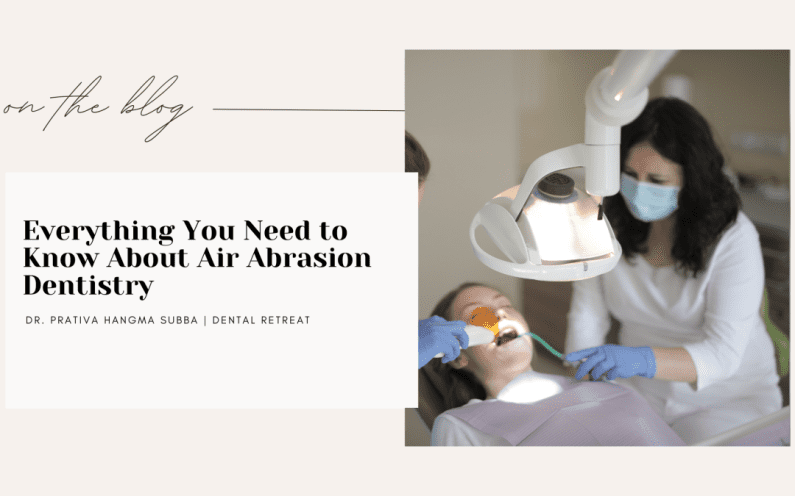Introduction
Air abrasion dentistry is an innovative, minimally invasive dental technique that is transforming how cavities and small enamel defects are treated. By eliminating the need for traditional drills, this method offers patients a quieter, pain-free, and precise dental experience.
In this article, we’ll explore everything about air abrasion dentistry, including how it works, its benefits, applications, and limitations. We’ll also discuss how it compares to other minimally invasive techniques, such as laser dentistry and ICON resin infiltration, linking these methods for a comprehensive understanding.
What Is Air Abrasion Dentistry?
Air abrasion is a technique used to remove small amounts of tooth decay or prepare teeth for restorations. It works by spraying a fine stream of particles, such as aluminum oxide or baking soda, at high speed onto the tooth’s surface. These particles gently wear away decayed or damaged areas without affecting healthy enamel.
Unlike traditional drills, air abrasion doesn’t produce heat, pressure, or vibration, making it an ideal choice for patients with dental anxiety or sensitivity.
How Does Air Abrasion Work?
The process involves:
- Preparation: The dentist isolates the treatment area to ensure no particles spread to other parts of the mouth.
- Application: A handheld device sprays a high-speed stream of particles combined with compressed air onto the tooth.
- Removal: The abrasive particles remove decay or prepare the tooth surface while suction devices clear debris.
- Finishing Touches: Once the process is complete, the tooth is ready for restoration or further treatment.
Benefits of Air Abrasion Dentistry
- Pain-Free Experience:
- No need for drills or anesthesia in most cases.
- Ideal for patients with low pain thresholds.
- Preservation of Healthy Tooth Structure:
- The precision of air abrasion ensures minimal damage to surrounding enamel.
- No Heat or Vibration:
- Unlike traditional drills, air abrasion doesn’t cause discomfort from heat or vibrations.
- Reduced Anxiety:
- Quieter and less intimidating than traditional dental tools.
- Versatile Applications:
- Effective for treating small cavities, repairing old fillings, and preparing teeth for sealants.
Applications of Air Abrasion Dentistry
- Cavity Removal:
Air abrasion is best suited for early-stage cavities, especially in children and adults with dental anxiety. - Preparation for Sealants:
Dentists use air abrasion to clean and roughen tooth surfaces before applying preventive sealants. - Removal of Stains:
Tough stains caused by coffee, tea, or tobacco can be effectively removed with air abrasion. - Repairing Old Restorations:
It can be used to remove and repair small cracks or chips in existing fillings. - Treatment of White Spots:
Air abrasion is a useful step before applying techniques like ICON resin infiltration to improve tooth aesthetics.
Air Abrasion vs. Other Minimally Invasive Techniques
- Air Abrasion vs. Laser Dentistry
While laser dentistry is effective for soft tissue procedures and some types of decay, air abrasion excels in treating small enamel defects and preparing teeth for restorations. - Air Abrasion vs. ICON Resin Infiltration
ICON resin infiltration is better suited for treating white spot lesions and early-stage cavities without altering the tooth structure. Air abrasion, on the other hand, is used to remove decay directly. - Air Abrasion vs. Traditional Drilling
Traditional drills are necessary for larger cavities or deep decay. Air abrasion is limited to small, shallow areas but offers a quieter, more comfortable experience. - Air Abrasion and Digital Smile Design
Incorporating air abrasion into Digital Smile Design plans allows for precise enamel preparation without compromising aesthetics.
Limitations of Air Abrasion
While air abrasion is an excellent tool, it has some limitations:
- Not Suitable for Deep Cavities: It’s primarily used for early-stage decay.
- Limited Material Removal: Can’t remove metals or large amounts of tooth structure.
- Requires Dry Conditions: Moisture can interfere with the effectiveness of the procedure.
Air Abrasion Dentistry in the Context of Minimally Invasive Dentistry
Air abrasion is one of many techniques highlighted in the Complete Guide to Minimally Invasive Dentistry. Like other methods, it prioritizes patient comfort and tooth preservation. When combined with approaches like laser dentistry and resin infiltration, it enhances the overall effectiveness of conservative dental care.
Also read our blog on Preventive Sealants: Shielding Smiles from Cavities
Who Can Benefit From Air Abrasion Dentistry?
- Children: Painless and quick, making it an excellent choice for pediatric dentistry.
- Adults: Ideal for patients with dental anxiety or sensitivity.
- Seniors: Gentle and effective for managing age-related enamel wear or decay.
Also read our blog on Ultra-Thin Veneers: Transforming Smiles with Minimal Intervention
Future Trends in Air Abrasion Dentistry
- Nano-Abrasive Technology: Emerging technologies may allow even finer particle streams for greater precision.
- Integration with AI Diagnostics: AI could identify decay patterns, optimizing air abrasion’s efficiency.
- Eco-Friendly Materials: Abrasive materials may evolve to include more sustainable options.
Conclusion
Air abrasion dentistry is a game-changer for patients and dentists alike. Its ability to treat small cavities, prepare teeth for sealants, and enhance aesthetics—all without the need for drills—makes it a cornerstone of minimally invasive dentistry. By combining it with techniques like laser dentistry and ICON resin infiltration, dentists can offer patients a truly pain-free and conservative approach to oral health care.
Read more on Silver Diamine Fluoride (SDF): A Breakthrough in Non-Invasive Dentistry
If you’re exploring your options for minimally invasive dental care, consider air abrasion as a gentle yet effective solution. For more information, visit our Complete Guide to Minimally Invasive Dentistry or explore related topics like Digital Smile Design and Minimally Invasive Dental Implants.
